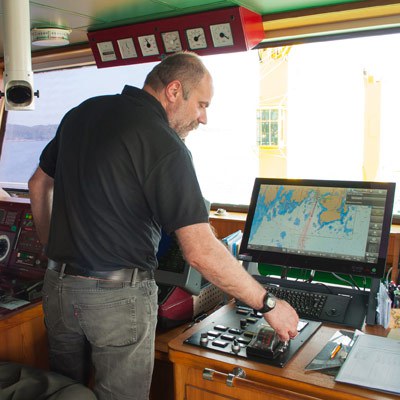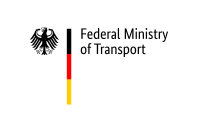Navigational equipment
Safety of navigation with modern navigational equipment
Seagoing vessels without modern navigational equipment are unthinkable nowadays and ensure safety of navigation. Among the most important navigational means are the automatic identification system (AIS), electronic chart display and information system (ECDIS), long range identification and tracking (LRIT) and voyage data recorder (VDR).
AIS is a self-organized VHF transponder system aimed at improving the safety of navigationon inland and maritime waterways.
Chapter V of the SOLAS Convention establishes that
- ships with 300 GT and above engaged on international voyages
- cargo ships of 500 GT and above engaged on national voyages
- any passenger ships
have to be equipped with AIS.
All vessels that are equipped with AIS exchange automatically and continually information about the ship and its current maneuvering data with each other: identity of the ship, its exact position, course and speed, heading and rate of turn, navigational status (e.g. at anchor, restricted in ability to maneuver). This facilitates a better overview of the current traffic situation and contributes to collision avoidance. Especially during large volumes of traffic and poor visibility, the AIS has a clear advantage to radar, the interpretation of which requires a lot of experience and constant observation.
Furthermore, AIS with its AIS land stations opens up new possibilities for Vessel Traffic Services (with traffic control), Maritime Rescue Coordination Centers or Maritime Casualty Investigation.
AIS Class A are included in the appendix to A.1 of the European Marine Equipment Directive; therefore, an EU approval is required. AIS Class B and AIS SART are not listed in appendix A.1 and thus receive a national approval. The compliance with relevant standards of AIS land stations, AIS AtoN and AIS Airborne is certified with a "Statement of Conformity". An approval of these AIS classes is not necessary since they are not used on ships.
ECDIS is an interactive electronic navigation information system for ships which facilitates the simultaneous display of navigational charts, the current position of the ship as well as its movements and additional information (radar, AIS, echo sounder, etc.) on the screen. It assists the navigating officer in planning and monitoring the route and offers automatic alert functions for particular emergency situations.
An officially approved ECDIS has been recognized as an equivalent substitute for paper charts for the use on ships under German flag in compliance with SOLAS Regulation 19.2.1.4 chapter V.
According to Regulation V/19.2.10 SOLAS, the carriage of ECDIS is required for the following types of ship:
- passenger ships of 500 gross tonnage and more;
- tankers of 3,000 gross tonnage and more;
- cargo ships, other than tankers, of 10,000 gross tonnage and more;
- cargo ships, other than tankers, of 3,000 gross tonnage and more but less than 10,000 gross tonnage constructed on or after 1 July 2014;
Whether the installation of an ECDIS on a vessel allows for paper charts not to be carried on board is outlined in MSC.232(82), section 14 in conjunction with Appendix 6. According to which carriage of paper charts may only be forgone in case of complete technical redundancy.
To be recognized as a full replacement for official paper charts on board seagoing vessels or fulfillment of mandatory carriage requirements, ECDIS must meet the following requirements:
- The ECDIS system must have been type-tested and approved to the applicable IMO and IEC (International Electrotechnical Commission) performance standards by an officially appointed body (“notified body”).
- Use of official ENCs (Electronic Navigational Charts) for the area to be navigated is mandatory with ECDIS. The official ENCs for Northern and Central Europe are held by the data centres IC-ENC (International Centre for ENCs) at Taunton (United Kingdom) and PRIMAR at Stavanger, Norway.
- In case official ENC data for the area to be navigated are not yet available, ECDIS is allowed to be operated in “RCDS mode” using official raster data. However, in this case, a reduced folio of up-to-date official paper charts has to be carried as well. The ship’s master is responsible for selecting suitable charts on the following basis:
- General route appraisal or ocean passage: medium-scale charts in the 1 : 750,000 to 1:1.500,000 range;
- General route appraisal or open seas: medium- scale charts in the 1 : 100,000 to 1 : 500,000 range;
- General route appraisal or navigation in congested coastal waters, pilotage waters or harbour approaches; charts having a scale larger than 1 : 100,000.
- Suitable back-up arrangements for ECDIS must be provided to ensure safe arrival of the vessel at the port of destination in the event of an ECDIS failure. Under current provisions, the following options are possible:
- installation of two identical ECDIS, or
- installation of an approved ECDIS-Backup in addition to the ECDIS or
- carriage of a complete folio of up-to-date official paper charts.
The requirement under paragraph 3. regarding the carrriage of a reduced folio of up-to-date official paper charts when using official raster data in “RCDS mode” remains valid. As a matter of course, if the requirement of back-up arrangements is met with option 4.c., the reduced folio of charts can be viewed as part of the back-up arrangements.
If all of the four above requirements are met, no additional approvals are required for navigational use of ECDIS as a substitute for official paper charts.
LRIT is a system for long-range identification and tracking of ships. It consists of LRIT shipborne transmission equipment, service providers as well as LRIT data centres (further information is given in MSC.263(84)). Data of ships flying a European flag are channeled in a joint EU Data Centre.
Communication equipment designated for LRIT has to be operating at all times; in high-risk areas in particular, ships should send the LRIT position information non-stop (i.e. do NOT switch off the transmission). Shipping companies have to notify the flag state about an interruption of operation or permanent suspension of a LRIT; in Germany to LRIT@BSH.de
LRIT equipment requirements
The requirement to be equipped with LRIT applies to the following ships in international trade
- passenger ships, including high speed craft
- cargo ships, including high speed craft, with a GT of 300 and above
- mobile offshore drilling units
Excluded from the equipment requirement are the following vessels:
- ships with radio equipment (in accordance with SOLAS Regulation IV/8) regardless of their date of construction, provided that these ships exclusively navigate in sea area A1 (in accordance with the definition of SOLAS Regulation IV/2.1.12) and are equipped with an AIS (in accordance with SOLAS Regulation V/19.2.4);
- authority vessels and vessels of the navy
- vessels involved in national trade
- Even if fishing vessels are not required to be equipped with an LRIT system, the German Flag State Administration recommends it for vessels navigating international waters. Among other things, the system contributes to the collection of data of the Maritime Rescue Coordination Centres (MRCCs) and prevents issues with other flag states.
Exemption from equipment requirement (Certificates of equivalence)
The BSH may exempt ships that would otherwise be required to be equipped with a LRIT system (based on SOLAS Regulations I/5 and V/3). Conditions for the exemption are:
- the ship is equipped with a properly functioning AIS (in accordance with SOLAS Regulation V/19.2.4)
- the area of trade is from or to European ports within coverage of AIS
If these conditions are met, you may apply for a Statement of Equivalence at the BSH. This statement has to be carried on board the ship as proof of the exemption.
If a ship does not meet the conditions for the exemption any longer (e.g. heading for an international port), the ship becomes required to be equipped with LRIT. Shipping companies or shipowners, respectively, have to notify the BSH accordingly.
The International Maritime Organization IMO stipulates that shipborne LRIT equipment has to be tested (Conformance Tests) in accordance with IMO Circular MSC.1/Circ.1307. The Test Application Service Providers (Test ASP) approved by the Flag State conduct these conformance tests. In case of a successful completion of the test, they issue Conformance Test Reports (CTRs).
For the German Flag the Federal Maritime and Hydrpgraphic Agency (BSH) has approved the following Test ASPs:
- Collecte Localisation Satellites (CLS)
- Kemilinks, Singapur
- Pole Star Space Appl. Ltd.
- Thrane & Thrane A/S
- Transas Telematics Ltd.
The VDR is a recoverable data recorder for use on seagoing vessels, which is the equivalent to aircraft flight data recorders.
In SOLAS Chapter V, Regulation 20 it is determined that all passenger vessels and all new ships of 3000 gross tonnage and above on international voyages have to be equipped with a VDR. Existing cargo ships on international voyages are to be retrofitted with an S-VDR (simplified VDR).
In their technical specifications, shipborne voyage data recorders are far superior to aircraft black boxes because they store a much larger variety of data. Besides the usual voice recording feature, VDR systems also record all important navigational and engine data as well as four radar and ECDIS pictures a minute. Two data protective capsules (submerssive capsule and free-floating capsule) store the recorded data of the last 48 hours. Older data is continuously overwritten with latest data. The submerssive capsule must be capable of withstanding heavy collisions, fires, and pressure conditions in several thousand metres of water.
Unlike shipborne automatic identification systems (AIS), VDR do not support safe navigation in the proper sense. The purpose of “Maritime Black Boxes” is to act as a reliable data source in the reconstruction of marine casualties. They will help to avoid past mistakes and increase the safety of navigation in general.
Voyage Data recorders require an EU certificate.
Type approval and surveys of navigational equipment
Here you will find further information regarding required surveys of navigational equipment on a newly built ship or when flagging in.


